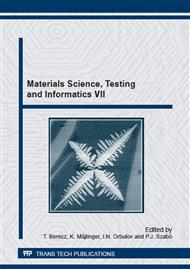p.271
p.279
p.285
p.291
p.297
p.303
p.309
p.315
p.321
A Method for the Determination of Ferrite Grains with a Surface Normal close to the (111) Orientation in Cold Rolled Steel Samples with Color Etching and Optical Microscopy
Abstract:
Cold rolled steel specimens were investigated by color etching. We proved that in this sample ferrite grains with a surface normal close to the (111) orientation are etched with the slowest speed with Beraha-I type color etchant, and that after a sufficient over-etching these specific grains could be distinguished based on this feature. It was demonstrated, that it is possible to stop the color etching in a phase when only grains with (111) orientation show color due to the layer interference, while all the other grains are dull gray due to a thick and transparent layer. This observation was utilized to develop a method to identify and quantify ferrite grains with (111) orientation in cold rolled steel samples with the application of color etching, optical microscopy and digital image post-processing.
Info:
Periodical:
Pages:
297-302
Citation:
Online since:
February 2015
Authors:
Price:
Сopyright:
© 2015 Trans Tech Publications Ltd. All Rights Reserved
Share:
Citation:


